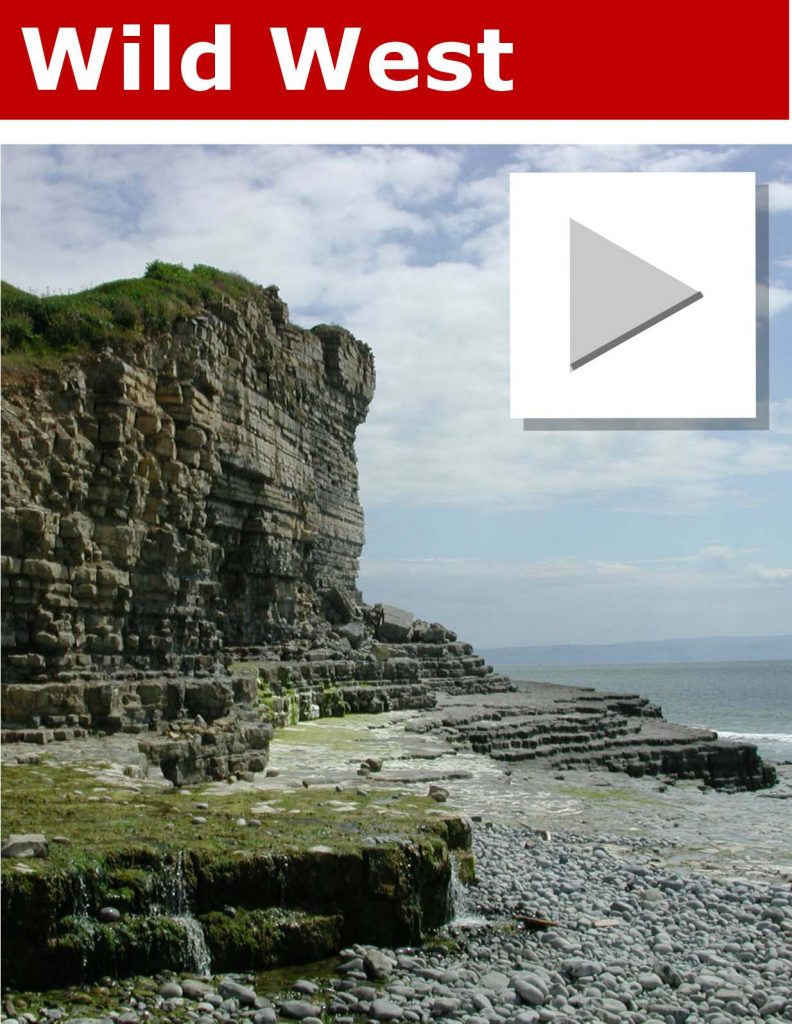To learn more about the 34,000-year-old remains of the Red Lady, our writer spent the night in the cave where his, yes, his bones were discovered in 1823

Mon 25 Apr 2011 07.59 BSTFirst published on Mon 25 Apr 2011 07.59 BS

It was probably more interesting 34,000 years ago. Then, from Paviland cave you would have seen mammoths, rhinos, oryx, vast herds of deer, even the odd sabre-toothed tiger, all roaming across the plain below. Now it’s just water – the Bristol Channel swashing against the jagged rock beneath the cave, Lundy Island in the distance, the coast of south-west England beyond that.
Paviland is only accessible for a couple of hours a day – unless you fancy a tricky climb – so I’ve decided to stay here for 24 hours, sleeping in the cave, sunbathing on the rocks, and wishing I’d brought some board games to play with my companions, local survival expert Andrew Price and photographer Gareth Phillips.
Paviland cave, on the Gower peninsula in South Wales, is a crucial site for tracing the origins of human life in Britain. It was in here, in 1823, that William Buckland, the first professor of geology at Oxford University, excavated the remains of a body that had been smeared with red ochre (naturally occurring iron oxide) and buried with a selection of periwinkle shells and ivory rods. Buckland initially thought the body was that of a customs officer, killed by smugglers. Then he decided it was a Roman prostitute – he wrongly believed the iron-age fort on the hilltop above the cave was Roman. This misidentification gave the headless skeleton its name – “the Red Lady of Paviland” – and it is still called the Red Lady, even though we now know two things Buckland didn’t: the remains are those of a young man, probably in his late 20s, and they were buried 34,000 years ago. The Red Lady is the oldest anatomically modern human skeleton found in Britain, and Paviland is the site of the oldest ceremonial burial in western Europe.https://www.visitswanseabay.com/destinations/gower-peninsula
https://www.visitwales.com/explore/west…gower/explore-award-winning-gower
To get in touch with this epic slice of pre-history I have chosen to sleep in the very spot where the Red Lady was discovered. I’m not sure what I expect to get out of this – a metaphysical connection with one of the first modern humans to come to these islands perhaps; the spiritual uplift pagans who visit this cave get when they come to pay homage to a figure they regard as a shaman. But in reality all I get is bitten on the hand by a spider. If Price had told me before the tide came in that there were spiders and bats in the cave, I probably wouldn’t have stayed. https://www.visitwales.com/explore/west-wales/swansea-mumbles-gower
Price has known the cave (called Goat’s Hole by locals) since he was a boy and is fascinated by the Red Lady. He likes to think spiritual significance was attached to the cave – larger than the others hereabouts, with an evocative, teardrop-shaped mouth – as a burial chamber. “I don’t think the aesthetics would have been lost on people then,” he muses. “And, even if you just look at it in practical terms, sitting up here gives you a great view of your hunting grounds.” Then, with global temperatures colder and sea levels lower, the estuary was miles back from the cave, and the plain teemed with the animals on which the small hunter-gatherer groups depended. They tracked herds of deer across hundreds of miles, and Paviland is likely to have been a stopping-off point on their annual round.
Excavators who came after Buckland found thousands of flints on the floor of the cave, suggesting it was in regular use, even though a few thousand years after the Red Lady was buried temperatures fell further, the ice advanced and Britain was abandoned by early man, leaving the cave’s occupant to lie alone for thousands of years.
As I struggle to get to sleep on the rocky, uneven floor of the cave, I try to dwell on his fate and conjure up the millennia, but all I can register is my tiredness and the constant boom of the sea as it penetrates the hollows in the cliffs.
Price believes the Red Lady was an important man. “Judging by the items that were found, I think he would have played a significant role. The ivory rods clearly had some ritualistic or artistic use. They weren’t hunting tools or anything like that, and that leads me to believe that his role in their society was of either religious significance or as a leader of some sort. I lean towards the idea that he might have been a mystic of some kind, or someone with a spiritual connection.”
What might be called the Welsh romantic view of the Red Lady is given academic backing by a monograph called Paviland Cave and the Red Lady: A Definitive Report, edited by archaeologist Stephen Aldhouse-Green and published in 2000. Aldhouse-Green argues that Paviland had been a “locus consecratus” – a sacred place – for more than 5,000 years. Unfortunately for the definitive report, the skeleton had been wrongly dated to 26,000 years ago, and the case for the symbolic importance of the cave and the possible shamanistic status of its occupant is now thought distinctly sketchy.
Marianne Sommer, in her book Bones and Ochre: The Curious Afterlife of the Red Lady of Paviland, makes the point that Welsh academics may have been seduced into making the Red Lady part of an indigenous cultural narrative. The fact that the Definitive Report opens with a poem called The Wind celebrating the “swift antiquarian/Who teaches me the antiquity of longing” and has a foreword by the then Welsh first minister Rhodri Morganemphasises the significance accorded to the Red Lady in Wales and helps to explain why the remains have become, as Sommer is not afraid to pun, “bones of contention”.
A few days after my stay in the cave, I go to meet the Red Lady – or at least his bones, in the Oxford University Museum of Natural History. They are too fragile to be put on display, but in the office of museum director, Jim Kennedy, I am allowed to touch them, wearing gloves and terrified of dropping them. The bones, stained red, are laid out in boxes, but you have no sense of the body, which is reckoned to have been 6ft tall, narrow-hipped and gracile – more African than European in body type and typical of a man who had to cover huge distances on foot. The skeleton is missing the skull, the long bones of the right side and vertabrae, all of which were presumed lost, either because of human disturbance or the effects of the sea – the cave suffers occasional inundations. https://www.nationaltrust.org.uk/days-out/regionwales/gower
Kennedy is not a romantic. He dismisses the notion that the Red Lady was a shaman and that the cave was a site for pilgrimage, seeing the burial as “a single event [of] a young man, for all we know a mammoth hunter, who got killed and was buried by his companions”. The rest, he reckons, should be silence, though it won’t be. “If people want to believe this is an important cultural site, they’ll believe it,” he says.
Kennedy’s views may be coloured by the battle he has fought against Welsh pagans and other campaigners who argue that the bones should be at a museum in Wales. Cyt ap Nydden, a druid based in Swansea (though he was originally an engineer from Birmingham called Chris Warwick) and a leading figure in the lobby group Dead to Rights, tells me that the ideal solution would be for them to be returned to the cave, where they could be exhibited under glass. He calls the removal of the bones “grave-robbing”, and says it would never have been permitted at the site of a Christian burial. Ap Nydden has also spent a night at Paviland, which he says was “warm and comforting” and exhibited none of the signs of spiritual disturbance he had expected. https://www.tripadvisor.co.uk › … › Swansea › Things to do in Swansea
He was clearly not bitten by a spider or bothered by bats.
At Oxford I also talk to Tom Higham, deputy director of the university’s radiocarbon accelerator unit, which redated the Red Lady to 34,000 years ago. “We found that instead of sitting where he had been before, in a cold period, it was actually in a much warmer interstadial [a relatively warm period within the ice age]. We think that’s why people were there. The pattern is emerging of people not really coming to the British isles unless it was warmer. You can imagine it being a peninsula [Britain was joined to the continent at that point] into which people didn’t go unless conditions were right.”
I ask Higham what we can deduce about the Red Lady. “This person probably had some kind of an accident. He’s a healthy person, not very old, doesn’t show any major signs of illness or disease. My guess is there was a hunting party, they were hunting in the environs of the site, there was an accident and the person was buried there.” The cave, in Higham’s view, was not a pagan cathedral but a convenient spot to leave a companion who had met an untimely end, and he says there is no evidence of subsequent pilgrimages, other perhaps than by doting druids and misguided journalists. His prosaic conclusion is unlikely to play well in the more poetic corners of Wales. http://www.explore-gower.co.uk/




